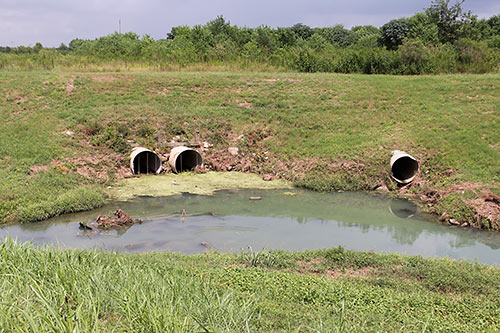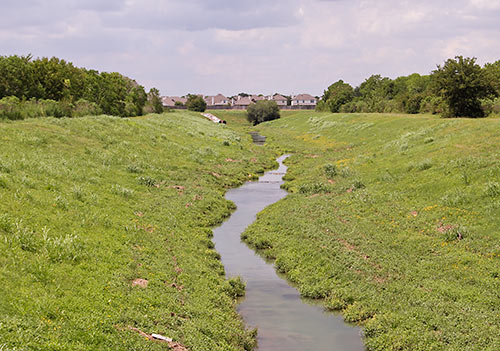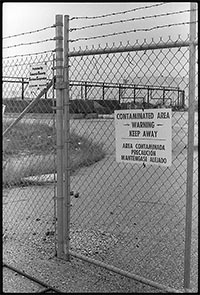COMMENT OF THE DAY: THE BRIO LATENCY EFFECT  “I moved to Sageglen in 1981 during kindergarten and went to Weber all the way through 6th grade and onto Webster. We played in the ditches catching crawdads, waded through flood waters, and drank the water freely. So many friends lived in Southbend so plenty of time was spent there as well playing throughout the neighborhood on what we thought were playgrounds and neighborhood pools. During the notification process of the contamination, my mother (Chinese and unable to read English at the time) was never aware of any class action suit. I, being a child, only knew we weren’t allowed to drink from the water fountains and didn’t even know what a class action suit or toxic contamination was at the time. Thus, we never signed up for it, nor received any compensation whatsoever. . . After reading all the accounts of vague health issues, I am realizing more and more that my own health issues are pretty much parallel. This cannot be a coincidence. Does anyone know of any sort of data collection on former residents to track the health implications? Or is there a class action suit still available to join; or has anyone filed another considering a lot of these issues are not presenting until adulthood? My biggest concern is: Will these issues be passed down and affect my own child? I just don’t feel this catastrophe and crime against so many people’s health/lives that we are all still/now finding out about should be a ‘closed’ case. We were oblivious kids back then without any idea of how this would affect us in our lives and well-being as adults.” [Marie, commenting on My Toxic Houston Childhood] Photo of Clear Creek near Brio Superfund site: Allyn West
“I moved to Sageglen in 1981 during kindergarten and went to Weber all the way through 6th grade and onto Webster. We played in the ditches catching crawdads, waded through flood waters, and drank the water freely. So many friends lived in Southbend so plenty of time was spent there as well playing throughout the neighborhood on what we thought were playgrounds and neighborhood pools. During the notification process of the contamination, my mother (Chinese and unable to read English at the time) was never aware of any class action suit. I, being a child, only knew we weren’t allowed to drink from the water fountains and didn’t even know what a class action suit or toxic contamination was at the time. Thus, we never signed up for it, nor received any compensation whatsoever. . . After reading all the accounts of vague health issues, I am realizing more and more that my own health issues are pretty much parallel. This cannot be a coincidence. Does anyone know of any sort of data collection on former residents to track the health implications? Or is there a class action suit still available to join; or has anyone filed another considering a lot of these issues are not presenting until adulthood? My biggest concern is: Will these issues be passed down and affect my own child? I just don’t feel this catastrophe and crime against so many people’s health/lives that we are all still/now finding out about should be a ‘closed’ case. We were oblivious kids back then without any idea of how this would affect us in our lives and well-being as adults.” [Marie, commenting on My Toxic Houston Childhood] Photo of Clear Creek near Brio Superfund site: Allyn West
Tag: Southbend
COMMENT OF THE DAY: HOME IS WHERE THE CHEMICAL WASTE IS  “I lived there from 1984-1990, from 2nd to 7th grade. I remember there being a ton of empty houses by the end. They never finished the neighborhood either, given that the problems occurred and people knew about it by the end. You’d have entire streets with 4 or 5 houses on it. My friends and I would play baseball, or football in those empty lots. We’d hit baseballs through windows of abandoned homes, and it’d be a dare to ‘go into that ghost house’ to get the ball back.
I remember going back in 1993 or so, and the entire place was empty, boarded up. It was sad. My dad and I hopped the fence and walked back to where our house was. We were there for about 5 minutes when the police came and wanted to know what the hell we were doing. Apparently, it’d become a place for squatters.
By 1995 the entire neighborhood was bulldozed to the ground. Now just an empty field. Yes, my dad lost a ton on that house. But we were part of that settlement that is mentioned. Paid for a small portion of my college, will pay for a tiny portion of my kids’ college. We were lucky in that I didn’t have any defects (that I know of), and my sister seems alright as well, though she had severe migraines at the time. It was a weird situation, especially for a 7-12 year old. But, I didn’t know it was ‘odd’ at the time. I just thought that it was cool, that I could break a window, or climb into a back yard to get a ball back, at a house that sat empty for 4 years. I thought it was ‘normal.’” [Matt, commenting on My Toxic Houston Childhood] Illustration: Lulu
“I lived there from 1984-1990, from 2nd to 7th grade. I remember there being a ton of empty houses by the end. They never finished the neighborhood either, given that the problems occurred and people knew about it by the end. You’d have entire streets with 4 or 5 houses on it. My friends and I would play baseball, or football in those empty lots. We’d hit baseballs through windows of abandoned homes, and it’d be a dare to ‘go into that ghost house’ to get the ball back.
I remember going back in 1993 or so, and the entire place was empty, boarded up. It was sad. My dad and I hopped the fence and walked back to where our house was. We were there for about 5 minutes when the police came and wanted to know what the hell we were doing. Apparently, it’d become a place for squatters.
By 1995 the entire neighborhood was bulldozed to the ground. Now just an empty field. Yes, my dad lost a ton on that house. But we were part of that settlement that is mentioned. Paid for a small portion of my college, will pay for a tiny portion of my kids’ college. We were lucky in that I didn’t have any defects (that I know of), and my sister seems alright as well, though she had severe migraines at the time. It was a weird situation, especially for a 7-12 year old. But, I didn’t know it was ‘odd’ at the time. I just thought that it was cool, that I could break a window, or climb into a back yard to get a ball back, at a house that sat empty for 4 years. I thought it was ‘normal.’” [Matt, commenting on My Toxic Houston Childhood] Illustration: Lulu

Inspired by reading René Steinke’s new and recently optioned-for-film novel Friendswood, the plot of which centers on the aftermath of the Brio Superfund mess just south of I-45 and the Beltway, Cite magazine’s Allyn West returns to the former chemical waste facility at Dixie Farm Rd. and Beamer Rd. to snap some photos and have a look around: “The first thing you pass is a landfill. And then, incongruously, you pass archetypal subdivisions with bucolic names, much like Southbend must have been. There’s a dedicated bike lane on both sides of Dixie Farm, clearly marked and freshly painted. Then turning toward the site onto Blackhawk Boulevard, you pass Ashley Pointe, a new subdivision. That morning, I saw construction workers milling about around unfinished stick frames. If Southbend still existed, Ashley Pointe would sit right next to it.”

Blogger Maritza Valle grew up in Southbend, next to the Brio Superfund site, just west of San Jacinto College’s South Campus:
I lived in a toxic waste dump when I was young.
Yes, let it sink in like the waste sank into our ground and somehow contaminated the water.
When I was young, I can’t remember how young, my mother and I moved in with Gamma, my maternal grandmother. Maybe I was about 7 because my brother was there too. I still remember the address: 11606 South Arbor, Houston Texas 77089. It was a subdivision, pretty new, with a nice school just around the block, and our house had a back yard opposite a huge field. Every once in a while, men in weird space-suit looking outfits would come out and mess around with the ground, which concerned me because there were cows out there, and then leave. . . .
COMMENT OF THE DAY: NOT MUCH HAPPENING SOUTH OF CLEAR BROOK LANDING “. . . Beamer Road is a special case because of the Brio Superfund Site. There was a waste processing plant that had disposed of a great deal of material from various refineries by dumping it into earthen pits. That was not standard practice; this was Houston’s Love Canal. The Brio site has been contained to prevent additional seepage through the groundwater, but the pollution that’s there would be far too expensive to remediate. So yeah, unless your friend got a chunk of that sweet sweet settlement, he’s probably **** out of luck.” [TheNiche, commenting on Comment of the Day: Where the Townhomes Ain’t]

